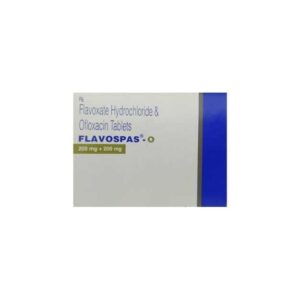OFLOXACIN + FLAVOXATE HYDROCHLORIDE
Ofloxacin: Ofloxacin is a fluoroquinolone antibiotic used to treat various bacterial infections. It works by inhibiting the replication of bacteria by blocking the enzymes responsible for DNA replication and repair.
It is commonly prescribed to treat respiratory tract infections (such as pneumonia, bronchitis), urinary tract infections, skin and soft tissue infections, and sexually transmitted infections (such as gonorrhea). Ofloxacin may also be used in the treatment and prevention of certain types of anthrax.
The dosage and duration of treatment may vary depending on the specific infection being treated, its severity, and the patient’s age and overall health. It is typically taken orally, either with or without food, or as an ophthalmic solution for treating eye infections.
Potential side effects of ofloxacin include nausea, vomiting, diarrhea, stomach pain, dizziness, headache, and blurred vision. It may also cause photosensitivity, making the skin more prone to sunburn. In rare cases, it can lead to serious side effects such as tendonitis, tendon rupture, or allergic reactions. If any severe side effects occur, it is important to seek medical attention immediately.
Ofloxacin should not be used by individuals with a history of hypersensitivity to fluoroquinolones or have experienced tendon disorders related to the use of this class of antibiotics. It is also not recommended for use in pregnant or breastfeeding women, as its safety has not been established in these populations.
As with any medication, it is important to follow the prescribed dosage and complete the full course of treatment as directed by the healthcare provider to ensure the effectiveness of the drug and minimize the risk of antibiotic resistance.
Flavoxate Hydrochloride: Flavoxate Hydrochloride is a medication primarily used to relieve symptoms associated with overactive bladder, such as frequent urination, urgency, and incontinence.
The drug works by relaxing the smooth muscles of the urinary bladder, reducing muscle spasms and increasing bladder capacity. Its exact mechanism of action is not completely understood, but it is believed to have both anticholinergic and direct muscle relaxant effects.
Flavoxate is usually taken orally in the form of tablets or extended-release capsules. The typical recommended dose for adults is 100-200 mg three to four times a day, preferably with meals and at bedtime. However, the dosage may vary depending on the individual’s response and medical condition. It is important to follow the instructions given by the doctor or pharmacist.
Like any medication, Flavoxate Hydrochloride may cause certain side effects. The most common side effects include dry mouth, blurry vision, dizziness, drowsiness, headache, upset stomach, constipation, and difficulty sleeping. These side effects are usually mild and temporary. However, if they persist or worsen, it is advisable to consult a healthcare professional.
In some cases, Flavoxate may cause more serious side effects such as fast or irregular heartbeat, fever, difficulty breathing, severe abdominal pain, or allergic reactions. If any of these occur, immediate medical attention should be sought.
It is important to note that Flavoxate Hydrochloride may not be suitable for everyone. Individuals with certain medical conditions, such as glaucoma, urinary or gastric obstruction, or myasthenia gravis, or those taking certain medications may need to avoid or adjust the dose of Flavoxate. It is crucial to inform the healthcare provider about any existing medical conditions or medications being taken before starting Flavoxate.
In conclusion, Flavoxate Hydrochloride is a medication used to alleviate symptoms associated with overactive bladder. It relaxes the smooth muscles of the bladder and increases its capacity. It is generally well-tolerated, but may cause side effects such as dry mouth, drowsiness, and dizziness. If any concerning side effects arise, a healthcare professional should be consulted.


